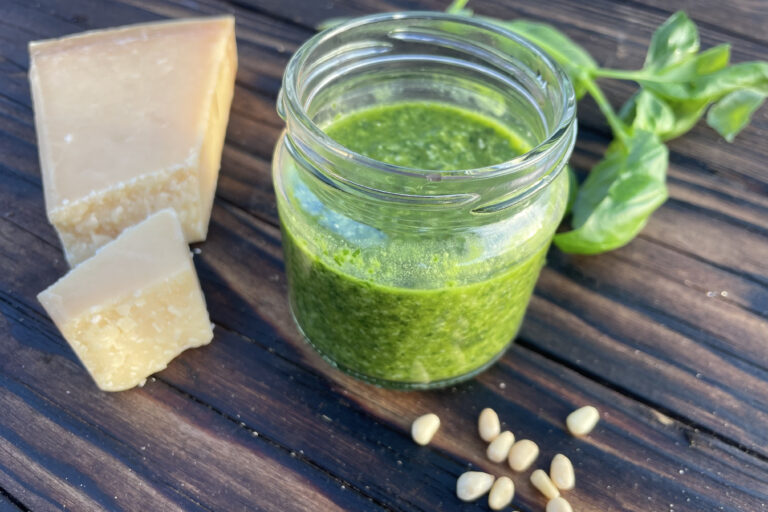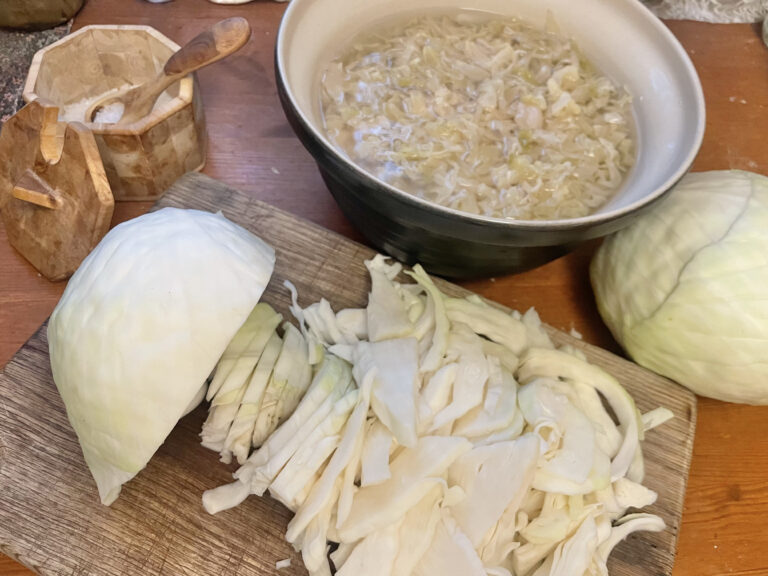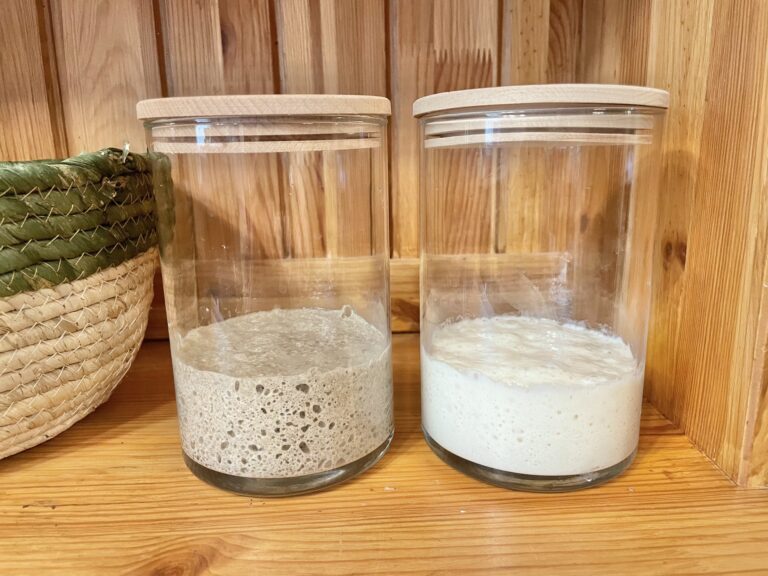I’ve grown up with brined wild mushrooms made by my grandmother and mother from a young age. In my childhood home, we always brined Rufous Milkcap, a mushroom highly esteemed in our house. For my own family, I’ve brined various wild mushrooms – milkcaps, porcinis, chanterelles and brittlegills. When it comes to frying mushrooms, making mushroom salad, pasta or preparing a pie, chanterelles, milkcaps, and brittlegills work best. Porcini mushrooms are best used for making mushroom puree soup. Mushroom puree soup is a year-round staple in our family’s menu, and I highly recommend trying the recipe!

You can enjoy brined mushrooms in various ways – as a healthy snack or in a variety of dishes like mushroom salad, mushroom puree soup, mushroom sauce, or mushroom pie. Brined mushrooms absorb only the taste of salt and maintain their original texture quite well, making it easy to prepare the aforementioned dishes.
Before starting, come and follow me on Instagram, Facebook, and Pinterest!
What you’ll need to make brined mushrooms
A pot – for boiling mushrooms.
A slotted spoon – for transferring mushrooms. You can do without it, but I find it the easiest method.
Salt – You will need about 1 tbsp of salt for 1l of water.
Mushrooms – any mushrooms you want to preserve over the winter.
How to make brined mushrooms
Brining mushrooms involves some simple steps to ensure a tasty and easy result. Firstly, ensure the wild mushrooms you want to preserve are safe to eat. Then determine whether the mushrooms need to be boiled, as this is essential before brining them. Finally, preserve the mushrooms in jars, but you can also consume them immediately after boiling. I’ll explain both boiling and canning in more detail below.
- If needed, boil and clean the mushrooms.
- Place the mushrooms in a pot. There’s no need to leave extra space in the pot.
- Add water to the pot, enough so that later you can fill the mushroom jars with the same water. Make sure all the mushrooms are submerged in the water.
- Add salt.
- Boil the mushrooms for 10-15 minutes. If you plan to eat the mushrooms immediately, you can boil them for a bit longer, adjusting the time until they reach your desired taste. For preserving in jars, you don’t need to boil them as long.
- Once the mushrooms have shrunk, you can transfer them to jars and pour the same brine you used for boiling over them. It’s convenient to use a slotted spoon to transfer the mushrooms to the jars.

How to boil poisonous or bad-tasting mushrooms
Boiling wild mushrooms can be a somewhat tricky process. Let’s start with whether the mushroom is poisonous or just doesn’t taste good. If it’s simply a matter of taste, you can taste a piece of the mushroom during boiling to see if the bitter taste has disappeared or if it needs more time. However, boiling poisonous mushrooms is a highly responsible task, and in such cases, I cannot provide any specific advice other than not to take risks if you’re not confident. Never experiment with boiling poisonous mushrooms. There are certainly non-poisonous wild mushrooms suitable for initial boiling experiments, such as various types of milkcaps and brittlegills.
- Be sure to clean the mushrooms thoroughly before boiling. After boiling, mushrooms become soft, and cleaning them becomes less convenient. Nevertheless, a significant portion of forest debris rises to the surface during boiling and can be easily skimmed off.
- Add water to the mushrooms. The exact amount of water isn’t crucial, but the less water you use, the quicker the boiling liquid gets dirty.
- Boil the mushrooms for 20-30 minutes, then change the water and boil them again. The more poisonous the mushroom, the more times it may need to be boiled. For mushrooms with merely unpleasant flavors, one to three boilings are generally sufficient. Once again, it’s crucial to experiment and learn boiling techniques while getting familiar with different types of mushrooms. Please note that I strongly discourage any experimentation with poisonous mushrooms.
- Finally, you can rinse the mushrooms with clean water to remove any lingering unpleasant flavors from the boiling liquid.

How to preserve brined mushrooms
It’s hard to say exactly how long canned brined mushrooms will last. From my childhood memories, I remember eating brined mushrooms that were several years old, and they were still good. However, it’s best to consume all canned food within a year. This way, you can make fresh and different preserves the following year!
There are many different methods for canning. You can use jars with either two-part or one-part lids. Many people have various opinions on how long and whether the jars should be heated, whether the lids should be disinfected, and if the jars should be cooled upside down after canning. There’s definitely a scientific explanation for all of these steps. I personally prefer water bath canning.
- Clean the jars you plan to use for canning thoroughly.
- Rinse the jars with water and disinfect in hot oven (100°C, 112 °F) for about 15 minutes.
- Arrange the jars on a towel, which will act as a hot pad during the filling process. It’s essential to ensure that the jars don’t cool down too much before filling, as this can cause them to break during the process.
- Boil the jar lids in a small pot on the stove. It’s crucial to disinfect and boil the lids properly!
- Fill the jars with the desired mixture, in this case, brined mushrooms. Pour the same saltwater that the mushrooms were boiled in over them. The brine should cover the mushrooms.
- Take one of the jar lids that have been boiled in hot water and place it on top of the jar, don’t close it too tightly.
Boil the jars in water for about 15 minutes.
- Let the jar cool. During cooling, a small dimple will form on the jar lid, indicating that a vacuum has formed, and air can no longer enter. Sometimes, you can even hear a little click when the vacuum forms.
Ideas and tips
- You can check the vacuum of the jar lids by tapping them, as you might not easily see the dimple on the lid with your eyes. A poorly sealed jar will make a lower sound when tapped compared to a well-sealed one. This is very noticeable, but if you’re uncertain, it’s always better to open the jar and reseal the lid.
- There are numerous methods for canning! If you’re accustomed to preserving differently, do it the way you know.
- You can also preserve the leftover saltwater from the mushrooms and use it later as broth in sauces or mushroom soups.
- I recommend trying pickled mushrooms using this recipe as well!


Brined mushrooms
Brining is a simple and quick way to preserve wild mushrooms for an extended period, and it doesn't affect the taste of the mushrooms.
Ingredients
- Mushrooms
- Water - just enough to cover the mushrooms and fill the jars later.
- Salt - 2 tbsp of salt for 1 l of water
Instructions
- If needed, boil and clean the mushrooms.
- Place the mushrooms in a pot. There's no need to leave extra space in the pot.
- Add water to the pot, enough so that later you can fill the mushroom jars with the same water. Make sure all the mushrooms are submerged in the water.
- Add salt.
- Boil the mushrooms for 10-15 minutes. If you plan to eat the mushrooms immediately, you can boil them for a bit longer, adjusting the time until they reach your desired taste. For preserving in jars, you don't need to boil them as long.
- Once the mushrooms have shrunk, you can transfer them to jars and pour the same brine you used for boiling over them. It's convenient to use a slotted spoon to transfer the mushrooms to the jars.
- Screw the lids on.
Nutrition Information:
Yield: 1 Serving Size: 1Amount Per Serving: Calories: 7Total Fat: 0gSaturated Fat: 0gTrans Fat: 0gUnsaturated Fat: 0gCholesterol: 0mgSodium: 7608mgCarbohydrates: 1gFiber: 1gSugar: 1gProtein: 1g





